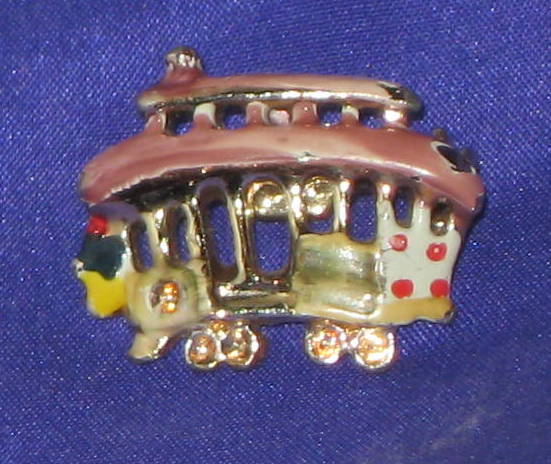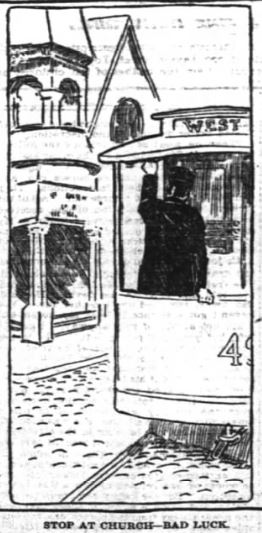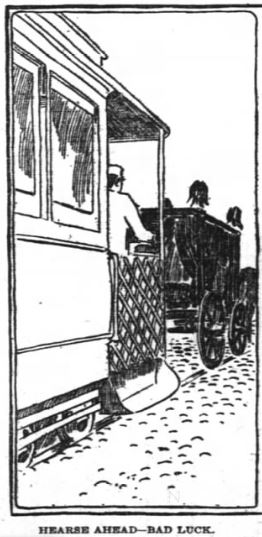Motormen’s Hoodoos

Lately I’ve been investigating “superstitions.” Particularly fascinating are the superstitions freshly woven around the “modern” technologies of the 19th and early-20th centuries. Finding such superstitions is the folkloric equivalent of the thrill a geologist gets from seeing land newly-born from a lava flow.
It has become axiomatic that “irrational beliefs,” always follow in the wake of increased technological complexity, as if belief must somehow balance science, lest the woo-factor of the Universe be diminished and we tip over into a fatal rationality. Judging by the persistence of “superstitions,” one wonders if, in the same way humans need certain vital gut bacteria and an exposure to dirt in childhood to maintain a healthy immune system, humans need a salutary dose of the illogical from time to time to top up whatever part of the brain it feeds.
That said, in 1900, superstition was, as I remarked in my post on Congressional superstitions, the mark of an inferior intellect or ethnicity. Here certain classes of men (I would have added miners and fishermen to the list.) are defined as “troubled” by superstition, with that exculpatory caveat about risking their lives. Let us jump on board and ride a few blocks with these troubling street-car superstitions.
Superstitions of Motormen
Street Car Employes Have Their Annoying Omens.
It is pretty generally known that men whose business requires that they risk their lives from day to day, or have the responsibility of other lives on their hands, become superstitious. The soldier, sailor, railway engineer, and motorman are all troubled with a certain amount of superstition and when the motorman of the trolley car acts strangely, a knowledge of his superstitious shortcomings may help to excuse an otherwise amusing or distressing incident.
According to the street car motorman’s version of the supernatural signs that show themselves to him during his day’s work, the best luck that can befall the man on the forward platform of a motor car, is to have a red-headed man run across the track in front of the approaching car. Motormen have been known to let a little more current make its way to the motors of their car when a red-headed man starts to cross the irons and add to his pace a little by an alarming wrestle with the warning gong.
Stopping in front of a church, whether the house of worship is situated at the street corner or in the middle of the block, is a bad sign and the motorman whose car becomes disabled in front of church usually finds that he might as well throw up his job and go to work on an elevator. Motormen often miss passengers who wait for their car at a corner where a church is situated and it behoves him who must catch a train to start early and walk a block to a corner not infested with a motorman’s hoodoo.

Second only to the hurried advent of the red-headed man in front of a car, is the good omen of a colored man boards the car while it is in motion. The faster the car moves when that dark complected person sets foot on the running boards and grabs the handles, the better is the omen of good luck for the car’s crew, especially the motorman. The motorman does not often increase the speed of his car, however, for if the intended passenger should meet with an accident and miss his footing, all the good luck is lost in the fall that follows.
When a funeral procession gets into the same street with his car, the motorman is on his mettle until the hearse has been left in the rear. To strike a hearse, or to even scratch one as his car goes by foretells that someone will be injured on the same trip.

All the good omens, as foretold by signs in the street car man’s life must be purely accidental. For instance, the motorman will not receive any benefit from the pass in front of his car, of a red-headed friend, who does so by request.
Motormen are also leery of striking another car, or a truck in the street. Even if no damage is done in these minor collisions, it is pretty generally admitted that they predict a late getting home for the motorman in charge.
When a new car, resplendent in bright paint, is given to a motorman for his run, no matter if the coach is fitted with the best of tracks, starts smoothly and brakes easily, the man at the controller box never rests until the first trip has been completed. To scratch a new car on the first trip is said to be a certain indication that a violent accident will soon follow the loss of paint.
Another occurrence which is frequent and not so reliable in its results, but which often disconcerts an otherwise steady motorman is to have a wagon turn from one side to the other before it leaves the track in front of the car. This is said to predict the docking of the motorman at the end of the day’s work, and from that point of view, the uncertain actions of the driver in front of the car, are certainly bothersome. To have the bell struck three times by a passenger, is a sinister omen, but the surest prediction of great misfortune, is to have the fuse blow out at a street corner. This will make the man of the switchbar shake his head with awe and run his car for the remainder of the day like a novice.
The motorman’s troubles are many and varied to a degree. Besides his superstitions, he has many other things to trouble him and bicyclists are not the least. All motormen agree that bicyclists are their greatest trouble. The wheelmen who persist in riding between the two tracks of a double track line as the car passes may be held responsible some day for the choking to death of a motorman, if that gentleman’s heart should at such a time get beyond his control; and jump into his throat.
Slippery rails, poor brakes, obsolete motors, jumping trolleys, empty sand-boxes, frozen switches and careless drivers all have their share in making the average motorman susceptible to the notions of superstition.
Grand Rapids [MI] Herald 2 September 1900: p. 4
An abbreviated version of the same list was found in a book of Kentucky superstitions in 1920. Would you find modern bus drivers today with the same notions?
And have any of you been in at the birth of any modern transport folklore? Plane-crashes-come-in-threes is just an extension of 19th-c. railroad engineer’s lore. Are there superstitions associated with the Underground? Drones? Electric cars? the Chunnel?
Trouble me with your superstitions at chriswoodyard8 AT gmail.com.
Chris Woodyard is the author of The Victorian Book of the Dead, The Ghost Wore Black, The Headless Horror, The Face in the Window, and the 7-volume Haunted Ohio series. She is also the chronicler of the adventures of that amiable murderess Mrs Daffodil in A Spot of Bother: Four Macabre Tales. The books are available in paperback and for Kindle. Indexes and fact sheets for all of these books may be found by searching hauntedohiobooks.com. Join her on FB at Haunted Ohio by Chris Woodyard or The Victorian Book of the Dead. And visit her newest blog The Victorian Book of the Dead.
